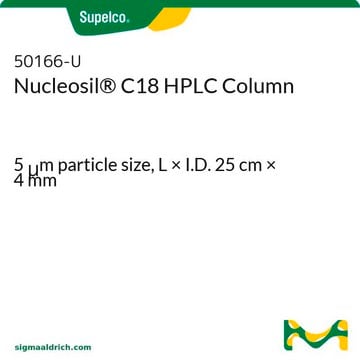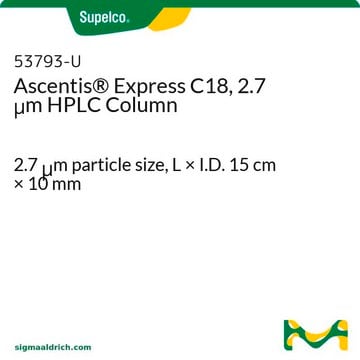Nothing special is required to use Ascentis Express HPLC columns. To obtain the full benefits of Ascentis Express, one should minimize dispersion in the HPLC system (tubing, detector flow cell) as well as confirm the detector response system is set at a fast level. For more information, request Guidelines for Optimizing Systems for Ascentis Express Columns (T407102).
53823-U
Ascentis® Express 90 Å C18 (2.7 μm) HPLC Columns
L × I.D. 10 cm × 2.1 mm, HPLC Column
Sinónimos:
Columna para HPLC C18 de tecnología Fused Core de núcleo cáscara (SPP)
About This Item
Productos recomendados
Nombre del producto
Columna para HPLC Ascentis® Express C18, 2,7 μm, 2.7 μm particle size, L × I.D. 10 cm × 2.1 mm
Materiales
stainless steel column
Nivel de calidad
Agency
suitable for USP L1
Línea del producto
Ascentis®
Características
endcapped
fabricante / nombre comercial
Ascentis®
envase
1 ea of
Parámetros
60 °C temp. range
600 bar max. pressure (9000 psi)
técnicas
HPLC: suitable
LC/MS: suitable
UHPLC-MS: suitable
UHPLC: suitable
L × D.I.
10 cm × 2.1 mm
superficie
135 m2/g
impurezas
<5 ppm metals
Matriz
Fused-Core particle platform
superficially porous particle
grupo activo de la matriz
C18 (octadecyl) phase
tamaño de partícula
2.7 μm
tamaño de poro
90 Å
pH operativo
2-9
aplicaciones
food and beverages
técnica de separación
reversed phase
¿Está buscando productos similares? Visita Guía de comparación de productos
Categorías relacionadas
Descripción general
Si desea más información sobre esta nueva tecnología de columna, visite la página de inicio Ascentis Express.
Aplicación
Análisis mediante UHPLC/MS de aceite de maíz en Ascentis® Express C30 en comparación con Ascentis® Express C18
Análisis mediante UHPLC del paracetamol e impurezas en Ascentis® Express C18, 2,7 μm
Análisis mediante HPLC de los parabenos en Ascentis®Express C18, 2,7 μm
Información legal
Aplicación
Producto relacionado
cartucho de precolumna
Palabra de señalización
Warning
Frases de peligro
Consejos de prudencia
Clasificaciones de peligro
Skin Sens. 1
Código de clase de almacenamiento
11 - Combustible Solids
Clase de riesgo para el agua (WGK)
WGK 3
Punto de inflamabilidad (°F)
Not applicable
Punto de inflamabilidad (°C)
Not applicable
Elija entre una de las versiones más recientes:
Certificados de análisis (COA)
¿No ve la versión correcta?
Si necesita una versión concreta, puede buscar un certificado específico por el número de lote.
¿Ya tiene este producto?
Encuentre la documentación para los productos que ha comprado recientemente en la Biblioteca de documentos.
Los clientes también vieron
Artículos
A significantly improved HPLC-fluorescence method for DMB-NANA and -NGNA, and application of this method to compare 2 candidate biosimilar therapeutic proteins to their respective RMs.
Derivatization of Aliphatic Amines - Results from the Supelco Ascentis Express column show higher peak resolution, and improved peak shapes than typical chromatograms.
Protocolos
A comprehensive sample preparation and analytical procedure was developed by Supelco for determining BPA in drinking water.
Supelco desarrolló un procedimiento integral analítico y de preparación de muestras para determinar el BPA en el agua potable.
We presents a robust method for analyzing 25-hydroxyvitamin D3 and 25-hydroxyvitamin D2 in serum using a multiplexed LC-MS-MS system.
This study demonstrates the analysis of Warfarin in plasma samples utilizing chiral and achiral (reversed-phase) LC-MS and effective sample prep to remove endogenous phospholipids
Contenido relacionado
Detailed list of mycotoxin analysis products for Food & Beverage manufacturers and testers, ensuring safety standards.
Chromatograms
application for HPLCapplication for HPLCapplication for HPLC-
Is there anything special I need to do to my HPLC system to use Ascentis Express?
1 answer-
Helpful?
-
-
Do I need special fittings and tubing to connect Ascentis® Express HPLC Columns?
1 answer-
While operating pressures may not exceed the 400 bar (6,000 psi) capability of your traditional instruments, sustained pressures of about 200 bar (3,000 psi) will exceed the recommended pressure for conventional PEEK tubing and fittings at the column inlet. We recommend changing to stainless steel fittings in all high pressure locations and have designed special High Performance HPLC Fittings/Interconnects that will stay tight at pressures of 1,000 bar (15,000 psi) or greater, even when elevated column temperatures are employed.
Helpful?
-
-
Can I use Ascentis Express on any type of HPLC system?
1 answer-
Ascentis Express HPLC columns are capable of use on standard HPLC systems as well as UHPLC systems. Columns are packed in high pressure hardware capable of withstanding the pressures used in UHPLC systems.
Helpful?
-
-
How can I measure my instrument bandwidth (IBW) and determine what Ascentis® Express HPLC Columns can be used with minimal efficiency loss created by too much internal instrument volume?
1 answer-
The Guide to Dispersion Measurement has simple instructions on how to measure IBW and can be found at sigma-aldrich.com/express.
Helpful?
-
-
What is the carbon load for Ascentis® Express C18 HPLC Columns?
1 answer-
Carbon load which is commonly referred to as %Carbon is misleading and not meaningful for Ascentis® Express. Since Fused-Core™ particle is unique in the sense that it has a solid core and porous shell, the %Carbon number can not be compared to traditional porous particles. The carbon coverage for Ascentis® Express C18 is 3.5 micromoles/meter-squared
Helpful?
-
-
What flow rate should I use with Ascentis® Express HPLC Columns?
1 answer-
Based on the minimum in the van Deemter curves, higher flows than 5um particle columns are required in order to maximize Ascentis Express column efficiency. The suggested starting point for flow rate for Ascentis Express columns: 1.6 mL/min for 4.6 mm ID; 0.8 mL/min for 3.0 mm ID; and 0.4mL/min for 2.1 mm ID.
Helpful?
-
-
What is the Department of Transportation shipping information for this product?
1 answer-
Transportation information can be found in Section 14 of the product's (M)SDS.To access the shipping information for this material, use the link on the product detail page for the product.
Helpful?
-
-
Can I use Ascentis Express on a UHPLC system?
1 answer-
Yes. Ascentis Express columns are packed in a way making them suitable for these ultra high pressure instruments. In fact, Ascentis Express outperforms sub-2 μm micron columns on many applications since Ascentis Express provides the benefits of sub-2 μm particles but at much lower back pressure. These benefits include the capability of providing fast HPLC and higher resolution chromatography. The Fused-Core particle consists of a 1.7 μm solid core and a 0.5 μm porous shell. A major benefit of the Fused-Core particle is the small diffusion path (0.5 μm) compared to conventional fully porous particles. The shorter diffusion path reduces axial dispersion of solutes and minimizes peak broadening.
Helpful?
-
-
Can Ascentis® Express HPLC Columns be used for LC-MS?
1 answer-
Express Fused-Core™ particles were designed with LC-MS in mind. Even extremely short column lengths exhibit sufficient plate counts to show high resolving power. The flat van Deemter plots permit resolution to be maintained at very high flow rates to maximize sample throughput. All Ascentis stationary phases have been evaluated for MS compatibility during their development, and the Express phases are no exception. You can expect extremely low column bleed and background while maintaining longest possible column lifetime. A bonus of Ascentis Express columns for high throughput UHPLC and LC-MS is that they are extremely rugged and highly resistant to plugging, a very common failure mode for competitor columns.
Helpful?
-
Active Filters
Nuestro equipo de científicos tiene experiencia en todas las áreas de investigación: Ciencias de la vida, Ciencia de los materiales, Síntesis química, Cromatografía, Analítica y muchas otras.
Póngase en contacto con el Servicio técnico












